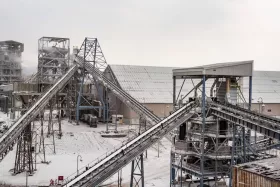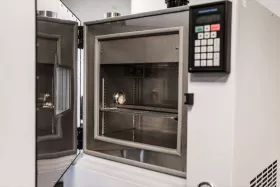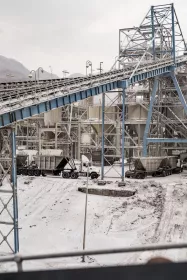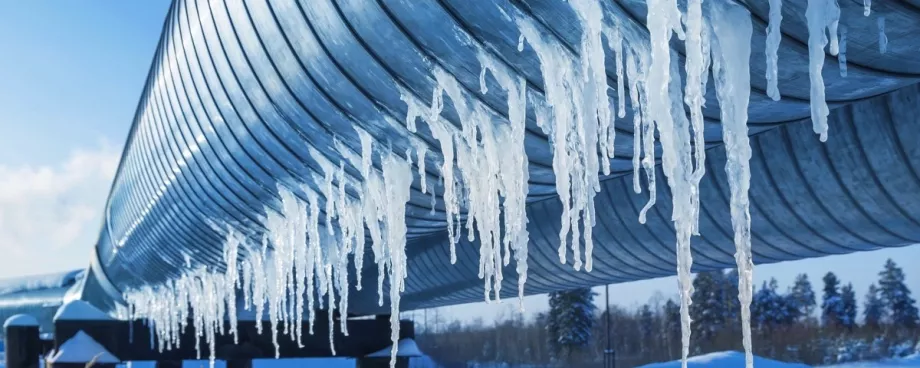Even short-lived freezing conditions can have a devastating effect on rubber conveyor belts. When the ambient temperature falls below -0°C rubber conveyor belts, both fabric multi-ply and steelcord constructions, begin to lose their elasticity. As the temperature continues to fall, the rubber continues to lose flexibility as well as its ability to resist abrasive wear, impact and cutting. Eventually the belt becomes so rigid it is unable to trough or pass around pulleys. The rubber belt covers and the rubber inside the carcass begins to crack. Ultimately, the belt will snap because when rubber is frozen it literally becomes so brittle it can shatter like glass.
What is regarded as ‘extreme’ Cold?

When it comes to rubber conveyor belts, the actual levels of temperature that can be used to define ‘extreme cold’ varies depending on the type (cover grade classification) of the rubber. For example, depending on the quality of manufacture, a good quality abrasion resistant belt can usually withstand temperatures as low as -30 to -40°C without too much trouble. However, other cover grades such as those that are resistant to fire or oil are usually only able to withstand a minimum temperature of -20°C.
Even if a conveyor may only very occasionally be subjected to temperatures lower than this, the sensible policy is to fit a belt that has been especially manufactured using a rubber compound engineered to withstand the effects of extreme cold. If the lowest expected temperature is borderline, say -15°C, there are still other considerations such as the wind chill factor and belts that have been standing idle overnight. During the day the friction between the drums and pulleys helps raise the temperature of the rubber. However, a long period of being static in cold conditions can create an abnormally low temperature in the belt so it lacks the necessary elasticity and flexibility at start-up. What can also happen is that the drive cannot provide enough power, which could feasibly then slip and damage the belt and even, ultimately, cut through it.
Testing for Cold Resistance

There are currently no international test methods in place for specifically determining the ability of a conveyor belt to function in extremely cold conditions. At Dunlop, our laboratory technicians literally test to breaking point by using a liquid nitrogen freezing cabinet to test samples of rubber belt at extreme low temperatures. The elastic modulus of the samples are first measured at an ambient temperature of 20°C. They are then placed inside the cabinet. The temperature in the cabinet is then gradually reduced by stages of 5°C. The elastic modulus of the samples is precisely measured at each stage to determine exactly when the decrease in flexibility of the rubber becomes too great, thereby identifying its lowest permissible ambient temperature.
As I touched on earlier, different rubber compounds that are designed to resist different demands (such as abrasion, fire or oil) have varying levels of resistance to extreme cold. This certainly applies to our range of cold resistant rubber compounds. For example, our cold and abrasion resistant rubber (Coldstar RAS) is designed to withstand temperatures as lower as low as -60°C, while other grades such as oil and fire resistant range between -40°C to -30°C.

To be fair, the market demand for cold resistance conveyor belts is the smallest of all belt types. This goes a long way to explain why it is so rare to find a conveyor belt manufacturer that includes specialist cold resistant belting in their product range.
However, at Dunlop it is part of our range because we serve customers all over the world who operate in a wide range of often very extreme climatic environments. That makes it important for us to offer a genuinely comprehensive range that meets the specific needs of all of our customers, no matter where they may be located.
Wear Resistance
Usually, the various special chemicals and additives used to make rubber compounds able to withstand specific demands such oil, fire, heat and cold have a negative effect on the ability of the rubber to withstand abrasive wear. In other words, oil, fire, heat and cold resistant belts typically have a shorter wear life. I’m proud to say that this is definitely not the case with our special resistant belts, quite the opposite in fact.
When developing our Coldstar RAS compound, our rubber compound engineers came up with something rather special. Not surprisingly, they maintain it was deliberate on their part but whatever the truth, it is rather amazing nonetheless. The fact is that the level of wear resistance that Dunlop Coldstar RAS compound possesses is pretty much unbeatable in comparison to conventional abrasion resistant rubber. The highest standard of abrasion resistance is DIN W, which demands a maximum loss of rubber during testing of 90 mm³. Under ISO 4649 / DIN 53516 test conditions, Coldstar RAS has an average loss under testing of only 35 mm³.
This puts it into a different class altogether when it comes to providing a long wear life, even in the harshest wear conditions. So, even if a belt is not subject to extremely low temperatures, if abrasive wear is a problem then perhaps there is a ‘miracle’ solution after all!
Concluding Advice
My advice when evaluating offers (and the accompanying technical datasheets) for cold resistant conveyor belts can best be summarised as follows:
- Always ask the potential supplier for details of the testing methods and criteria used for resisting extreme cold.
- Insist on a minimum level of resistance to abrasion (as per ISO 4649 / DIN 53516) of less than 150 mm³.
- Make sure that ozone & UV resistance (ISO 1431) is an automatic part of the specification when selecting any rubber conveyor belt.
■








Rubber Conveyor Belt
To survive in cold environments rubber conveyor belts are specially coated to make them wear and tear resistant otherwise extremely cold weather can affect the functioning of rubber conveyor belt.
■